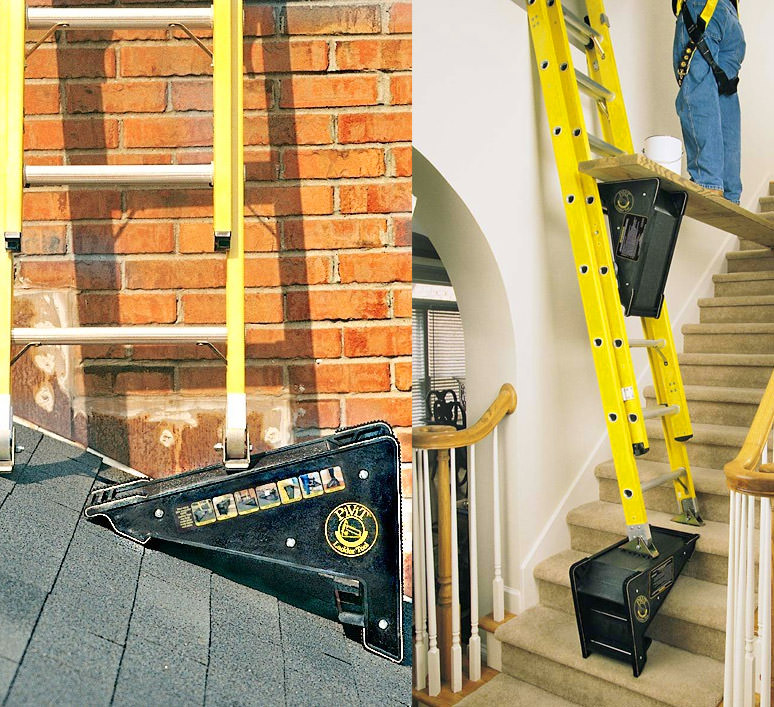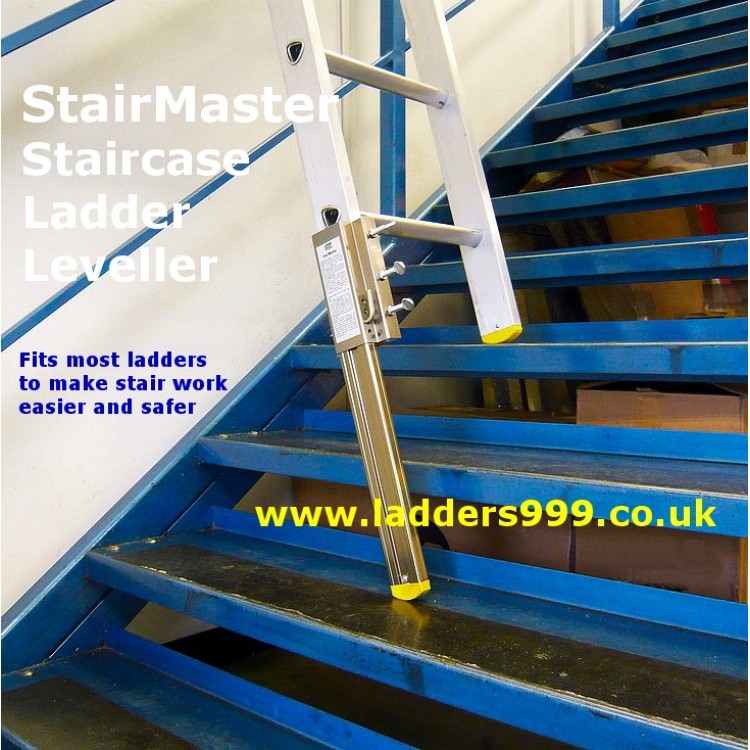Tools you wish you'd bought sooner...
Discussion
GeneralBanter said:
skwdenyer said:
Sketch it out with forces if you like  For all likely load cases, the lower step contact is a pin joint with a limiting level of lateral restraint.
For all likely load cases, the lower step contact is a pin joint with a limiting level of lateral restraint.
 For all likely load cases, the lower step contact is a pin joint with a limiting level of lateral restraint.
For all likely load cases, the lower step contact is a pin joint with a limiting level of lateral restraint. it’s not a pin joint if it’s on something like a nice slippy surface such as a lump of metal on carpet or the edge of a stair. In these cases any weight transfer to that side will be unrestrained with only friction at the top against the wall stopping it. So half way up a double extension where the bending moment is greatest is a risk.
it’s not a pin joint if it’s on something like a nice slippy surface such as a lump of metal on carpet or the edge of a stair. In these cases any weight transfer to that side will be unrestrained with only friction at the top against the wall stopping it. So half way up a double extension where the bending moment is greatest is a risk.It beggars belief these photos are used for marketing. For a start the ladders are just about vertical !
The ladder feet only act through friction, BTW. Almost every ladder leveller increases the frictional contact with the ground / supporting structure.
As regards the double extension ladder, which bending moment are you thinking of? Fore-aft? The force resultants at the ladder feet don’t change if the ladder’s a touch floppy in that duration. What do you envisage happens? That the bending somehow results in an increase in force acting at the floor so as to slide the ladder?
classicaholic said:
The fellow up the ladder looks as if he dressed for a day in the office.... then some weird turn of events saw him up a chimney stack.If that ladder did slip and fall, not only would the "office fellow" at the top cop it, but the fellow footing the ladder would be launched into the air as the ladder rotated. It'd certainly make for an amusing H&S video.
Edited by Scarletpimpofnel on Tuesday 21st November 23:06
Scarletpimpofnel said:
classicaholic said:
The fellow up the ladder looks as if he dressed for a day in the office.... then some weird turn of events saw him up a chimney stack.If that ladder did slip and fall, not only would the "office fellow" at the top cop it, but the fellow footing the ladder would be launched into the air as the ladder rotated. It'd certainly make for an amusing H&S video.
Edited by Scarletpimpofnel on Tuesday 21st November 23:06
finlo said:
I had the back of my house painted about 8 years ago by a local contractor, it’s 3 stories high and he just threw up a massive ladder just like that, made me feel sick and riddled with anxiety. The final few feet of the ladder (due to bend) was pretty much vertical. I had to go indoors and just leave them to it. I will repaint next spring but will get a scaffold put upBoom78 said:
finlo said:
I had the back of my house painted about 8 years ago by a local contractor, it’s 3 stories high and he just threw up a massive ladder just like that, made me feel sick and riddled with anxiety. The final few feet of the ladder (due to bend) was pretty much vertical. I had to go indoors and just leave them to it. I will repaint next spring but will get a scaffold put up
I don’t do ladders over 3m tall…
57Ford said:
Boom78 said:
finlo said:
I had the back of my house painted about 8 years ago by a local contractor, it’s 3 stories high and he just threw up a massive ladder just like that, made me feel sick and riddled with anxiety. The final few feet of the ladder (due to bend) was pretty much vertical. I had to go indoors and just leave them to it. I will repaint next spring but will get a scaffold put up
I don’t do ladders over 3m tall…

skwdenyer said:
You’ll have to sketch out what you mean, because it sounds like you think the base of a ladder plays a significant part in stopping a ladder from tipping laterally. If you move the CoG outside of the base width, *only* the wall friction is preventing the ladder from toppling sideways. There’s no moment reaction through the base - whether or not you use a ladder leveller.
The ladder feet only act through friction, BTW. Almost every ladder leveller increases the frictional contact with the ground / supporting structure.
As regards the double extension ladder, which bending moment are you thinking of? Fore-aft? The force resultants at the ladder feet don’t change if the ladder’s a touch floppy in that duration. What do you envisage happens? That the bending somehow results in an increase in force acting at the floor so as to slide the ladder?
The ‘ladder levellers’ in the photos reduce that friction significantly- possibly to near zero in some cases. The ladder bending causes a greater outward force away from the wall to overcome the friction that we know is reduced. The ladder feet only act through friction, BTW. Almost every ladder leveller increases the frictional contact with the ground / supporting structure.
As regards the double extension ladder, which bending moment are you thinking of? Fore-aft? The force resultants at the ladder feet don’t change if the ladder’s a touch floppy in that duration. What do you envisage happens? That the bending somehow results in an increase in force acting at the floor so as to slide the ladder?
As I’ve said nice slippy surfaces and ridiculous contraptions when at height are a disaster !
GeneralBanter said:
skwdenyer said:
You’ll have to sketch out what you mean, because it sounds like you think the base of a ladder plays a significant part in stopping a ladder from tipping laterally. If you move the CoG outside of the base width, *only* the wall friction is preventing the ladder from toppling sideways. There’s no moment reaction through the base - whether or not you use a ladder leveller.
The ladder feet only act through friction, BTW. Almost every ladder leveller increases the frictional contact with the ground / supporting structure.
As regards the double extension ladder, which bending moment are you thinking of? Fore-aft? The force resultants at the ladder feet don’t change if the ladder’s a touch floppy in that duration. What do you envisage happens? That the bending somehow results in an increase in force acting at the floor so as to slide the ladder?
The ‘ladder levellers’ in the photos reduce that friction significantly- possibly to near zero in some cases. The ladder bending causes a greater outward force away from the wall to overcome the friction that we know is reduced. The ladder feet only act through friction, BTW. Almost every ladder leveller increases the frictional contact with the ground / supporting structure.
As regards the double extension ladder, which bending moment are you thinking of? Fore-aft? The force resultants at the ladder feet don’t change if the ladder’s a touch floppy in that duration. What do you envisage happens? That the bending somehow results in an increase in force acting at the floor so as to slide the ladder?
As I’ve said nice slippy surfaces and ridiculous contraptions when at height are a disaster !
You're imagining that people will use these devices to foot a very tall extension ladder on a staircase (because only very tall extension ladders bend in the way you describe)?
And you believe that the fore-aft forces on the feet of the ladder will increase when the ladder is in a bent shape?
If so, why do you think that?
Even if that were true, you're saying you think the ladder stabilisation device provides less frictional reaction against (say) a stair tread than the original ladder feet. In the alternate, you might think the ladder stabilisation device is prone to toppling (because the ladder isn't bound to it, so there's a potential unconstrained rotational point at the ladder foot - device interface?
Considering the friction question, that will come down to the type of foot material, the load upon the feet, and so on. I don't think most of the devices illustrated above will provide *less* frictional reaction to a fore-after longitudinal force.
The toppling point will depend upon the design of the device. Considering the right-hand image here:

the key thing will be the user. Note in the picture, the ladder foot is towards the "front" (nearest the wall) face of the device, so that a straight line drawn extending the ladder to the lower step doesn't meet the step further "rearwards" than the foot of the device.
I agree, there's an opportunity for user error there - if the ladder foot is towards the "rear" of the device, the force resultants will create an increased risk of toppling due to the introduction of a turning moment onto the device. I *hope* the instructions are clear on that point, but I accept that the "watch this" school of instruction-avoidant manliness could cause a user to come a cropper by not understanding the physics!
That's why a design like this:

is better, so long as the ladder's at the correct angle.
The ideal is simply an extending leg on the ladder, of course; something like this:

but there's still plenty of scope for user error there

Jules Sunley said:
Pffft.....John Noakes going up Nelson Monument
Almost any video with Fred Dibnah - example here
THOSE send shivers down my spine!
skwdenyer said:
I see what you mean. The force on the feet in the fore-aft direction (relative to the wall) will be made up of two components: a primary vertical force, and a secondary (in magnitude) longitudinal force. The longitudinal force will in part be resisted in part by the friction of the top of the ladder against the wall.
You're imagining that people will use these devices to foot a very tall extension ladder on a staircase (because only very tall extension ladders bend in the way you describe)?
And you believe that the fore-aft forces on the feet of the ladder will increase when the ladder is in a bent shape?
If so, why do you think that?
Even if that were true, you're saying you think the ladder stabilisation device provides less frictional reaction against (say) a stair tread than the original ladder feet. In the alternate, you might think the ladder stabilisation device is prone to toppling (because the ladder isn't bound to it, so there's a potential unconstrained rotational point at the ladder foot - device interface?
Considering the friction question, that will come down to the type of foot material, the load upon the feet, and so on. I don't think most of the devices illustrated above will provide *less* frictional reaction to a fore-after longitudinal force.
The toppling point will depend upon the design of the device. Considering the right-hand image here:

the key thing will be the user. Note in the picture, the ladder foot is towards the "front" (nearest the wall) face of the device, so that a straight line drawn extending the ladder to the lower step doesn't meet the step further "rearwards" than the foot of the device.
I agree, there's an opportunity for user error there - if the ladder foot is towards the "rear" of the device, the force resultants will create an increased risk of toppling due to the introduction of a turning moment onto the device. I *hope* the instructions are clear on that point, but I accept that the "watch this" school of instruction-avoidant manliness could cause a user to come a cropper by not understanding the physics!
That's why a design like this:

is better, so long as the ladder's at the correct angle.
The ideal is simply an extending leg on the ladder, of course; something like this:

but there's still plenty of scope for user error there
You’ve got very wrapped up - ladder feet should never be on a slippy surface let alone on something that’s going to slip sideways and out!You're imagining that people will use these devices to foot a very tall extension ladder on a staircase (because only very tall extension ladders bend in the way you describe)?
And you believe that the fore-aft forces on the feet of the ladder will increase when the ladder is in a bent shape?
If so, why do you think that?
Even if that were true, you're saying you think the ladder stabilisation device provides less frictional reaction against (say) a stair tread than the original ladder feet. In the alternate, you might think the ladder stabilisation device is prone to toppling (because the ladder isn't bound to it, so there's a potential unconstrained rotational point at the ladder foot - device interface?
Considering the friction question, that will come down to the type of foot material, the load upon the feet, and so on. I don't think most of the devices illustrated above will provide *less* frictional reaction to a fore-after longitudinal force.
The toppling point will depend upon the design of the device. Considering the right-hand image here:

the key thing will be the user. Note in the picture, the ladder foot is towards the "front" (nearest the wall) face of the device, so that a straight line drawn extending the ladder to the lower step doesn't meet the step further "rearwards" than the foot of the device.
I agree, there's an opportunity for user error there - if the ladder foot is towards the "rear" of the device, the force resultants will create an increased risk of toppling due to the introduction of a turning moment onto the device. I *hope* the instructions are clear on that point, but I accept that the "watch this" school of instruction-avoidant manliness could cause a user to come a cropper by not understanding the physics!
That's why a design like this:

is better, so long as the ladder's at the correct angle.
The ideal is simply an extending leg on the ladder, of course; something like this:

but there's still plenty of scope for user error there

dickymint said:
Scarletpimpofnel said:
classicaholic said:
The fellow up the ladder looks as if he dressed for a day in the office.... then some weird turn of events saw him up a chimney stack.If that ladder did slip and fall, not only would the "office fellow" at the top cop it, but the fellow footing the ladder would be launched into the air as the ladder rotated. It'd certainly make for an amusing H&S video.
Edited by Scarletpimpofnel on Tuesday 21st November 23:06
Not sure safety hats would help at all.
Gassing Station | Homes, Gardens and DIY | Top of Page | What's New | My Stuff





 k That!
k That!
